Self Massage for Breast Feeding Baby
If you are pregnant or breastfeeding, milk expression by hand is a useful technique to learn. It's a handy way to relieve engorged breasts. You can also use it to stimulate milk production and provide milk for a baby who is not breastfeeding well or needs more milk.
Why hand expression?
If you use a pump
Practice helps
How breasts work
Before you start
Relax and get comfortable
How to hand express
Step by step
How long will hand expressing take?
Hand expressing shouldn't hurt
Why hand expression?
- Skin-to-skin contact with hand expression encourages the milk ejection reflex (MER) or 'let-down reflex'.
- Mothers usually get more milk using hand expression alone or combined with pumping than using just a pump.
- It requires no special equipment and is always available, even in emergencies.
- It's convenient and free.
Hand expression is particularly useful if you need to express colostrum during late pregnancy (see Antenatal Expression of Colostrum) or in the first few days after birth. It makes it easy to save every drop of precious colostrum.
If you use a pump
Whatever pump you may use, combining pumping with hand expression can help you express more milk more effectively.
- Breast massage and hand expression can be used at the beginning to get your milk flowing.
- Breast massage while pumping increases the amount of milk you can express.
- Continuing to hand express can release milk remaining, evenafter the pump flow has stopped.
- And if your pump breaks down, or there is no electricity, youalways have your hands.
Practice helps
Hand expression is simple to learn and gets easier with practice. You may receive information and a demonstration of hand expression from your midwife. Developing your own routine, starting with relaxation techniques and stimulating milk flow, makes it easier too.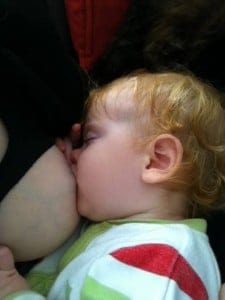
How breasts work
When milk is removed more often, your breasts feel soft and comfortable and produce milk faster. When milk is removed infrequently, your breasts may feel full but produce milk more slowly. Frequent milk removal is the key to maintaining milk production whether you are breastfeeding or expressing. Expressing stimulates your breasts—though not as effectively as a baby—to make and release milk.
For more information on how milk production works, click here.
Before you start
Wash your hands. Have a suitable clean container available to collect your milk: colostrum can be expressed into a small (5ml) container or even onto a teaspoon for immediate feeding. Once milk production has increased milk may spray in several directions so a bowl, wide mouthed container or a bottle with a funnel might be more practical.
Relax and get comfortable
Milk tends to flow better when you are feeling comfortable, relaxed and warm. Tension or anxiety inhibits milk flow. Relaxation techniques can help increase the amount of milk you can express. The sound of running water may help, or you could practise in the bath or shower.
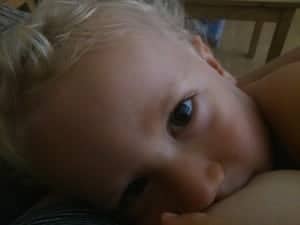
Seek privacy; try the breathing exercises you learnt for use during labour; visualise flowing milk. Have your baby nearby, or think of him. Use photos or recordings of your baby and smell his clothing. All these will help stimulate milk flow. Take a few deep breaths, drop your shoulders and release tension with each exhalation. Bending forward with your breasts suspended means gravity can help milk flow.
How to hand express
One basic approach
- Start by encouraging milk flow in both breasts.
- Then hand express from each breast until milk flow slows right down. If you need to increase milk production, continue expressing for a couple of minutes after milk flow has stopped.
- Repeat these two steps at least twice more. You will find milk flow slows or stops sooner each time you repeat.
- Most mothers adapt the above approach to suit themselves, so experiment to find what works best for you.
Step by step
Encouraging milk flow
Stimulating your milk ejection reflex (MER or 'let-down') is the key to expressing. It can take a few minutes. You may see drops of colostrum or breastmilk, or even experience a tingling sensation, but many mothers don't see any milk until they start actually expressing. Experiment with the following suggestions to find out what works best for you.
- Massage your breast starting at the top, using a firm circular pressure on one spot. After a few seconds, lift up your fingers to move to the next area on the breast. Spiral around the breast towards the areola and nipple.
- Stroke your breast from the top of the breast to the areola and nipple. Light stroking with fingers is one option, or use a soft item with a light tickle-like stroke. Continue this stroking motion from the chest wall to the nipple around the whole breast.
- Shake your breast gently while leaning forward so gravity can help your milk flow.
Hand position
You can use either or both hands on one breast, or express both breasts at the same time. Hold your hand in the shape of a letter 'C', with your thumb and forefinger behind the base of your nipple, feeling for the change in texture of your breast. Move you fingers closer to, or away from your nipple to find the best place for you.
To express
Start with the pad of your thumb at the top of your breast, and your finger pads below.
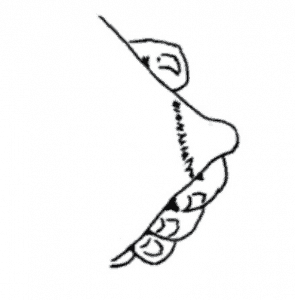
Support your breast, then press the breast towards the chest wall to put pressure on the milk ducts.
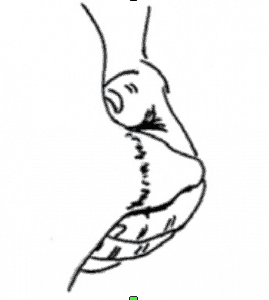
Now compress the breast between your fingers and thumb to move the milk forward towards your nipple.
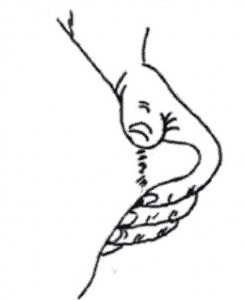
Release and repeat rhythmically: press—compress—relax (like a baby breastfeeding) until milk flow stops

Then rotate your hand around the breast a little and repeat. Do this for each section of your breast until it feels soft and comfortable. Keep your fingers and thumb opposite one another as you rotate.
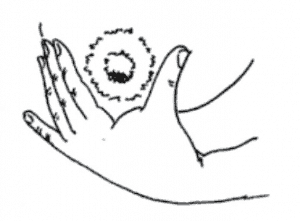
Remember that when a baby breastfeeds, milk doesn't flow immediately, so it's normal for it to take a little time for milk to start flowing when you express. Switch back and forth between breasts as the flow slows to encourage further MERs.
This video has a good demonstration of hand expression of breastmilk
How long will hand expressing take?
Allow plenty of time at first: the whole process may take 20 or 30 minutes, but you can always stop and start again later if you need to. Frequent short sessions are usually more effective than infrequent, longer expressing sessions.
Switching between breasts several times as milk flow slows can help trigger further milk ejection reflexes. The more MERs you stimulate, the more milk you will be able to express and make.
Hand expression shouldn't hurt
Squeezing, pulling and sliding fingers along the skin can cause discomfort, bruising and skin burns. Pain or discomfort inhibit the MER and are signs that something needs adjusting. If your breast feels engorged or tender try warm moist heat immediately before expressing. Start expressing from the most comfortable areas.
Removing milk from areas around a blocked duct can reduce the discomfort, making it easier to express from the tender area later.
Written by Sue Upstone, Karen Butler and mothers of LLLGB.
Further Reading
The Womanly Art of Breastfeeding. LLLI. London: Pinter & Martin, 2010.
Breastfeeding Answers Made Simnple. Mohrbacher, N. Amarillo, Tx: Hale Publishing, 2010.
Antenatal Expression of Colostrum
Birth and Breastfeeding
Expressing Your Milk
Engorged Breasts – avoiding and treating
My Baby Needs More Milk
Sleepy Baby – why and what to do
Storing Your Milk
Working and Breastfeeding
Bottles and other tools
You can buy this information in printed form from the LLLGB shop.
LLLI Resources
The Power of Hand Expression
Copyright LLLGB 2016
Source: https://www.laleche.org.uk/hand-expression-of-breastmilk/
0 Response to "Self Massage for Breast Feeding Baby"
Post a Comment